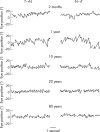Age related change of optokinetic nystagmus in healthy subjects: a study from infancy to senescence
- PMID: 15548816
- PMCID: PMC1772432
- DOI: 10.1136/bjo.2004.044222
Age related change of optokinetic nystagmus in healthy subjects: a study from infancy to senescence
Abstract
Background: Optokinetic nystagmus (OKN) gain is asymmetrical between temporal to nasal (TN) and nasal to temporal (NT) stimulation in infancy and decreases at older ages. The age at which OKN gain becomes symmetrical and decreases is debated. The aim was to investigate OKN over the whole lifespan in a large sample of healthy subjects.
Methods: In a prospective, cross sectional study OKN was tested monocularly using TN and NT small field stimulation. Stimulation velocity was 15 degrees /s and 30 degrees /s for children aged under 1 year (n = 97), and 15 degrees /s, 30 degrees /s, 45 degrees /s, and 60 degrees /s for older subjects (1-9 years, n = 66; 10-89 years, n = 86). Gain was measured using infrared oculography.
Results: Significant OKN gain asymmetry in favour of TN versus NT stimulation was found during the first 5 months of life (p<0.05). Only at 11 months of age was OKN symmetrical in 100% of the subjects. The percentage of children with symmetrical OKN decreased with increasing stimulus velocity. OKN gain increased in the second and third years (p<0.05 for 15 degrees /s), remained stable until 50 years of age, and showed a small but significant decrease afterwards for the tested velocities (between 6% and 18%, p<0.05).
Conclusions: Infrared oculography is an accurate method to assess OKN, especially in children. Knowledge about change of OKN in healthy subjects could be helpful to interpret OKN in patients with abnormal binocular vision or lesions of the central nervous system.
Figures



Similar articles
-
Look and stare optokinetic nystagmus in healthy subjects and in patients with no measurable binocularity. A prospective study.Klin Monbl Augenheilkd. 2005 Mar;222(3):196-201. doi: 10.1055/s-2005-858013. Klin Monbl Augenheilkd. 2005. PMID: 15785979
-
Role of the stimulus size in the generation of optokinetic nystagmus in normals and in patients with retinitis pigmentosa.Klin Monbl Augenheilkd. 2004 May;221(5):390-4. doi: 10.1055/s-2004-812864. Klin Monbl Augenheilkd. 2004. PMID: 15162288
-
Optokinetic nystagmus in strabismus: are asymmetries related to binocularity?Invest Ophthalmol Vis Sci. 2003 Dec;44(12):5142-50. doi: 10.1167/iovs.03-0322. Invest Ophthalmol Vis Sci. 2003. PMID: 14638710
-
Open-loop and closed-loop optokinetic nystagmus in squirrel monkeys (Saimiri sciureus) and in man.Prog Brain Res. 1989;80:183-96; discussion 171-2. doi: 10.1016/s0079-6123(08)62212-8. Prog Brain Res. 1989. PMID: 2699364 Review.
-
OKN asymmetry in human subjects: a literature review.Strabismus. 2013 Mar;21(1):37-49. doi: 10.3109/09273972.2012.762532. Strabismus. 2013. PMID: 23477776 Review.
Cited by
-
Psychophysical testing in rodent models of glaucomatous optic neuropathy.Exp Eye Res. 2015 Dec;141:154-63. doi: 10.1016/j.exer.2015.06.025. Epub 2015 Jul 2. Exp Eye Res. 2015. PMID: 26144667 Free PMC article. Review.
-
Precision and accuracy of ocular following: influence of age and type of eye movement.Exp Brain Res. 2010 Mar;201(2):271-82. doi: 10.1007/s00221-009-2036-6. Epub 2009 Oct 15. Exp Brain Res. 2010. PMID: 19841914
-
Nystagmus Associated With the Absence of MYOD Expression Across the Lifespan in Extraocular and Limb Muscles.Invest Ophthalmol Vis Sci. 2023 Sep 1;64(12):24. doi: 10.1167/iovs.64.12.24. Invest Ophthalmol Vis Sci. 2023. PMID: 37703038 Free PMC article.
-
Diagnosis of colour vision deficits using eye movements.Sci Rep. 2022 May 11;12(1):7734. doi: 10.1038/s41598-022-11152-5. Sci Rep. 2022. PMID: 35562176 Free PMC article.
-
Normative data for ages 18-45 for ocular motor and vestibular testing using eye tracking.Laryngoscope Investig Otolaryngol. 2021 Aug 21;6(5):1116-1127. doi: 10.1002/lio2.632. eCollection 2021 Oct. Laryngoscope Investig Otolaryngol. 2021. PMID: 34667856 Free PMC article.
References
-
- Westheimer G , McKee S. Visual acuity in the presence of retinal-image motion. J Opt Soc Am 1979;65:847–50. - PubMed
-
- Yee R , Baloh R, Honrubia V. Pathophysiology of optokinetic nystagmus. In: Honrubia V, Brazier M, eds. Nystagmus and vertigo. London: Academic Press, 1982:251–75.
-
- Teller D , Succop A, Mar C. Infant eye movement asymmetries: stationary counterphase gratings elicit temporal-to-nasal optokinetic nystagmus in two-month-old infants under monocular test conditions. Vis Res 1993;33:1859–64. - PubMed
-
- Atkinson J , Bradick O. Development of optokinetik nystagmus in infants: an indicator of cortical binocularity? In: Fisher D, Monty R, Senders J, eds. Eye movements: cognition and visual perception. Hilldale, NJ: Laurence Erlbaum Associates, 1981:53–64.
-
- van Hof-van Duin J , Mohn G. Vision in the preterm infant. In: Prechtl H, ed. Continuity of neural functions from prenatal to postnatal life. Philadelphia: Lippincott, 1984:93–114.
MeSH terms
LinkOut - more resources
Full Text Sources
Medical
Research Materials
